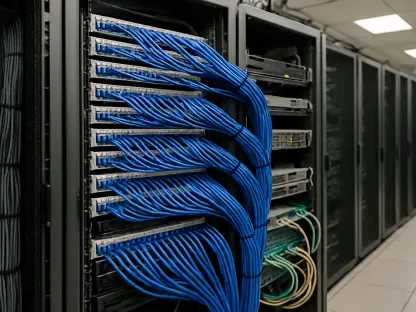Listen to the Article
In an era where disruption has become the norm rather than the exception, businesses are waking up to an undeniable truth: resilience is no longer a “nice-to-have.” It’s a survival imperative. Companies that can adapt and maintain continuity are the ones that thrive when faced with cyberattacks, supply chain bottlenecks, or unexpected market shifts. Amid these challenges, one critical enabler often flies under the radar, though: smarter networking.
This article will explore how intelligent, agile networks are emerging as the foundation of business resilience in 2025, and why companies investing in networking innovation today will have a decisive advantage tomorrow.
From Static Infrastructure to Dynamic Ecosystems
For decades, traditional networking infrastructure operated much like static plumbing—efficient but rigid. However, the digital transformation accelerated by the pandemic revealed just how fragile inflexible systems can be. According to Gartner, 85% of enterprises worldwide are expected to adopt a “cloud-first” strategy by the end of 2025, relying heavily on networks that can flex, scale, and adapt, because cloud technology is no longer just a tool—it’s the backbone of digital transformation.
Companies today need vibrant ecosystems—networks that are integrated seamlessly between not just offices, but also cloud platforms, IoT devices, remote workers, and partners around the world. Smarter connectivity is creating environments where data flows securely, performance scales in an instant, and recovery is built in.
The Link Between Networking and Business Continuity
In case of disaster, business continuity is often a matter of how resilient and flexible a company’s network is. Research shows that businesses with end-to-end, intelligent network management permeating their operations are 40% more likely to be back in business following operational disruption compared to businesses with legacy systems.
Consider the rise of SD-WAN (Software-Defined Wide Area Networking) technologies. For example, by abstracting control away from hardware, this connectivity solution allows businesses to reroute traffic, prioritize critical applications, and maintain performance—even when traditional network links are down. For global enterprises, this means offices on different continents can stay online and connected even when regional outages occur.
Smarter Networking Enables Secure Resilience
As businesses adopt hybrid work models and expand their cloud footprints, the traditional perimeter-based security approach is crumbling; it is no longer sufficient to protect organizations from sophisticated attacks. Zero-trust networking is now the baseline.
According to a statement by Forrester, 72% of enterprises plan to implement zero-trust frameworks by the end of 2025. Syteca highlights that this suggests a significant shift towards the “never trust, always verify” approach to cybersecurity.
Smart networks feature authentication, encryption, and real-time monitoring at every node and connection point, ensuring that threats are discovered early and isolated quickly.
Agility: The New Measure of Network Success
Today’s competitive landscape demands rapid change. Whether it’s bringing new digital services to market, shifting to remote work, or responding to new regulations, organizations need connectivity solutions that will accelerate change, not stand in its way.
That is where network technologies like network automation, AI-driven monitoring, and intent-based networking start to play a role. While automation simplifies tasks, AI-driven monitoring automatically identifies and resolves problems, and intent-based networking translates business goals into effective network configurations that enable networks to self-manage. A Cisco 2024 AI Readiness Index survey found that organizations using AI-based network management reduced outages by 45% and remediation by half.
Automation makes dull work like configuration, provisioning, and troubleshooting faster and less prone to errors. This enables companies to gain the agility to change operations, expand services, and capitalize on opportunities as they arise.
Smarter Networking Fuels Innovation
In addition to resilience, intelligent networks create a platform for innovation.
Take manufacturing, for example. An IoT sensor-rich smart factory with hundreds of sensors needs a network that can not only handle the amount of data but also process it for meaningful information. This intelligent system enables the factory to anticipate equipment failure before it happens, balance the production lines in real time, and enhance workers’ safety without compromising security or compliance at any given time.
In healthcare, smarter connectivity is the catalyst behind telemedicine, remote diagnosis, and AI-based treatments that significantly improve patient outcomes. The common thread is that companies that invest in smarter networking now, are laying the foundation for future innovations.
The Cost of Standing Still
Failure to modernize networks exposes firms to business disruption. According to a 2024 report by the Uptime Institute, 16% of outages cost organizations over $1 million. A recent survey conducted by Acronis revealed that more than 60% of downtime incidents cost over $100,000 in damages, a 39% increase from 2019. The loss of reputation is normally even worse.
If you cling to traditional connection architectures, you are constructing on quicksand because legacy networks collapse under growing data demands, increasing cyber threats, and evolving workspaces. They require costly manual maintenance and lack the visibility needed for proactive management.
Building a Smarter Network Strategy for 2025 and Beyond
So, how do businesses put their networks in place to enable resilience and growth?
Automate first. Reduce human error and response time with AI and machine learning solutions.
Apply zero-trust principles. Secure your digital assets by default by assuming that any access request is potentially malicious until it is confirmed otherwise.
Invest in cloud-native networking and SD-WAN. Make network controls independent of the physical hardware to foster flexibility and resiliency.
Prioritize observability. Install real-time network monitoring tools that provide actionable insights, not notifications.
Design for scalability. Engineer networks that are able to scale horizontally and vertically as business requirements evolve.
Final Thoughts: Networking as a Strategic Lever
Business resilience used to mean having a disaster recovery plan tucked away in a binder. Today, it means designing every layer of your operations—including your network—to adapt, recover, and thrive amid uncertainty.
Intelligent connectivity is and should no longer be just the concern of IT departments. It’s a boardroom issue, a competitive advantage, and the backbone of future-proof enterprises.
As 2025 unfolds, the question today is: Can your business afford not to invest in smarter networking?









